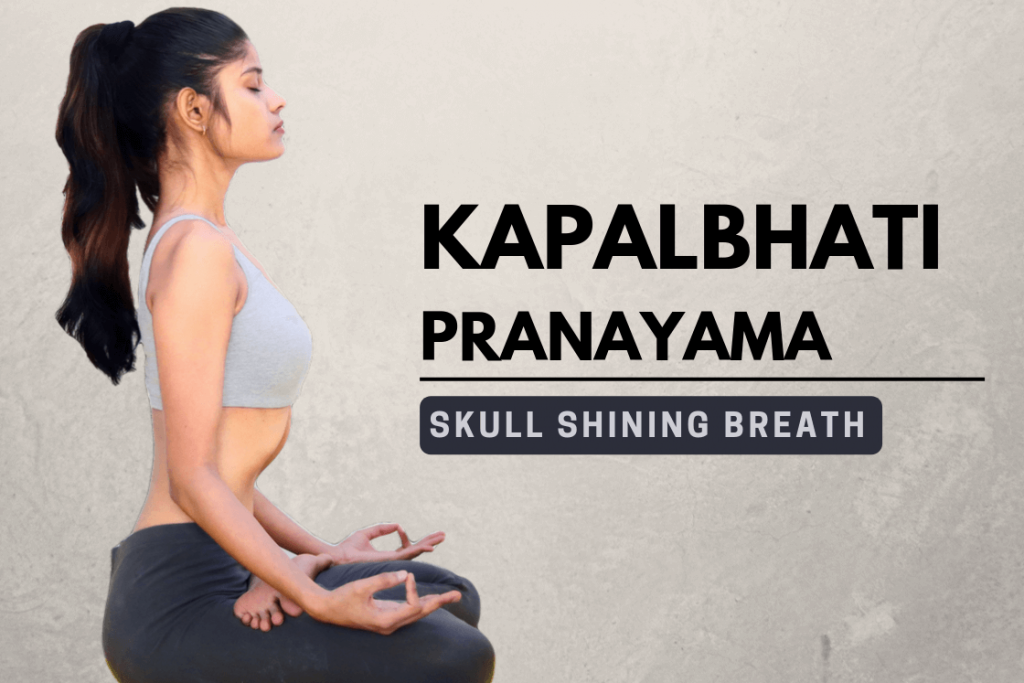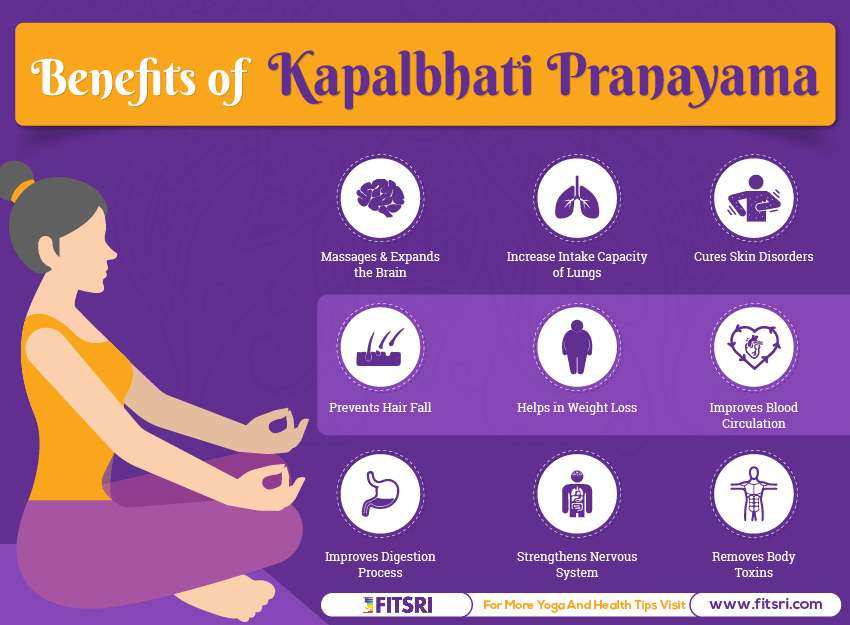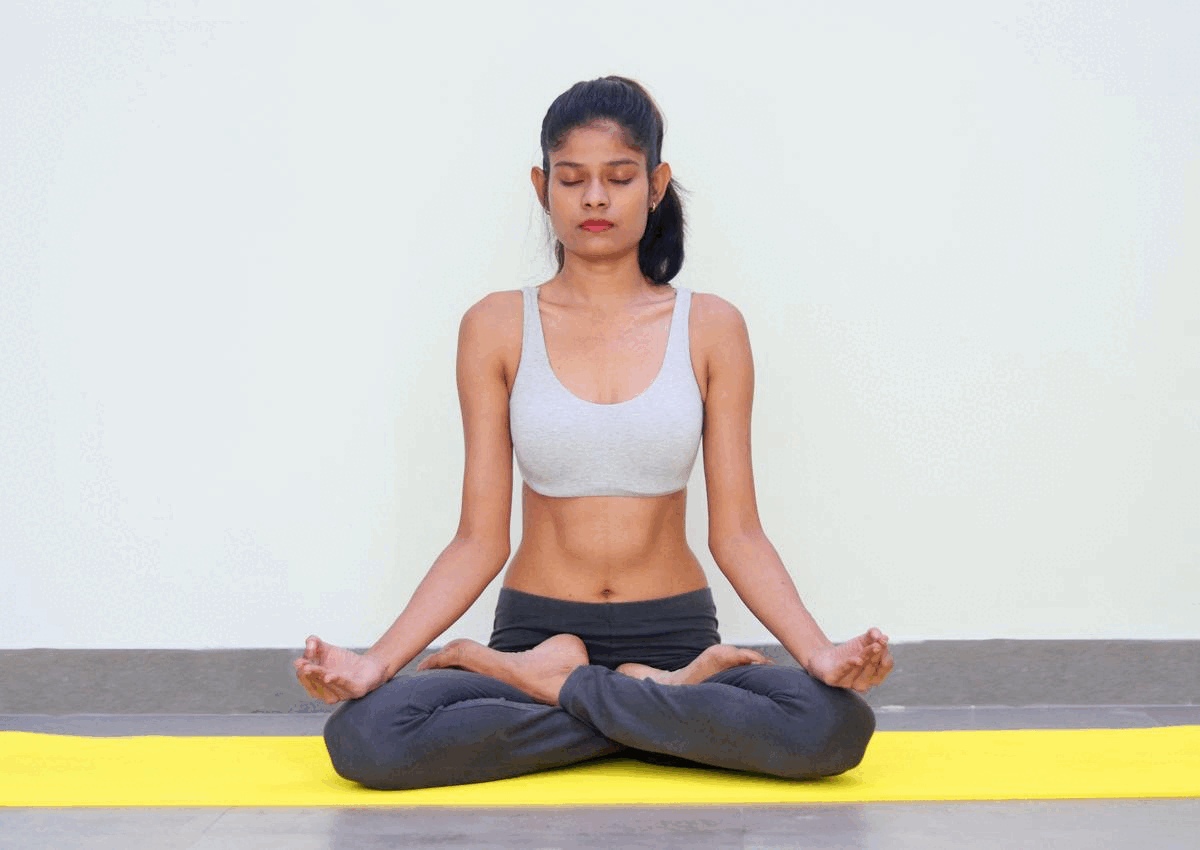
Do you know what makes kapalbhati the most practised breathing exercise of yoga – the invigorating energy it brings, the profound clarity it instills, and the transformative impact it has on both mind and body.
In each stroke of kapalbhati, a normal person expels 100 ml extra carbon die oxide (CO2) than normal breathing. This means more toxins are released in every stroke of kapalbhati.
Kapalbhati pranayama is a wonderful breathing technique of yoga that involves powerful rapid exhalations followed by short and passive inhalations. The following inhale is an automatic response from the lungs being empty.
Kapalbhati’s technique of forced exhalation helps to reduce stress, boost brain function, and improve respiratory health. It also strengthens the abdominal muscles and improves digestion.
In this article, we’ll look more closely at the benefits of Kapalbhati pranayama and provide detailed steps for how to do it.
What is Kapalbhati?
Kapalbhati is a basic breathing technique of yoga (Pranayama). It comprises short, powerful exhales and gentle inhales synch with abdominal movement. As you inhale deeply through both nostrils, expand the chest and abdomen. While exhaling, rapidly draw the abdomen back and expel the air out. Exhale will automatically be followed by a short inhale and then exhale as previously.
However today it’s practised as pranayama, in the ancient yogic text Hatha Yoga Pradipika, Kapalbhati is mentioned as one of the “shat kriya” or “six cleansing techniques” of yoga.
When practicing Kapalbhati, you are essentially cleansing the frontal lobes of your brain. Moreover, it also clears the nasal passage and improves the efficiency of the respiratory system.
In contrast to normal breathing, where inhale is active and exhale is passive, during kapalbhati, you inhale passively and exhale forcefully. The exhale, which requires you to contract your abdominal muscles, is the main focus of this pranayama.
Kapalbhati means “Skull Shinning”
Kapalbhati literally translates as “skull shining”. In the Sanskrit word Kapalbhati, kapal means ‘skull or frontal head‘ and bhati means ‘shinning‘.
Through the practice of kapalbhati, it has been seen, practitioner’s forehead, skin start shining and the efficiency of the frontal brain increases. As you practice it, after a few times, you can feel the lightness in the head and your skull being filled with light. Therefore, they call it “skull shining breath” or Kapalbhati pranayama.
Kapalbhati pranayama is also called “Breath of fire“. Rapid and forceful exhalation strokes in kapalbhati generate a lot of internal heat in the body.
This heat removes the toxins and other waste materials from the body in the form of sweating and expelling CO2. Also, internal heat glows the skin, forehead shining, and digestion better.
Benefits of Kapalbhati Pranayama

Through the practice of kapalbhati, you gain multiple physical and mental benefits. Your respiratory system gets strengthened. Along with this, the digestive system is also stimulated and strengthened due to the active engagement of the abdominal muscles.
Mentally, kapalbhati increases oxygen and blood circulation to the brain that will help in improving focus, concentration, and mental clarity.
While these are only a few benefits that you can reap from regular practice, additional benefits are as follows:
- Practicing kapalbhati strengthens respiratory muscles and increase lung capacity.
- Kapalbhati clears the nadis. It encourages detoxification which paves way for a healthy and glowing skin.
- kapalbhati pranayama aid in reducing hair loss and stimulate the scalp for hair growth by increasing oxygen supply to head.
- Kapalbhati is one of best pranayama techniques for weight loss. It enhances the metabolic activity and helps to burn out the belly fat.
- It cures common digestive problem such as stomach pain, gas, ulcers, constipation or diarrhea.
- Kapalbhati effectively control the diabetes. It stimulates pancreas which in turn helps in the secretion of insulin.
- It makes a diabetic person strong enough to fight against many diseases such as heart problems, kidney problems, eye damage & Alzheimer’s disease.
- Kapalbhati boosts your immune system which will inherently help you fight diseases.
- It is known to calm and de-stress the mind making you get rid of anxiety and tension.
- It promotes the production of endorphins, which will keep you happy and positive.
- Women can greatly benefit from practicing kapalbhati as it helps in regulating mentrutation and prevent mentrual cramps.
- The kapalbhati can energize your brain which will improve your concentration and memory.
What the science says
Kapalbhati has been extensively studied, the existing research suggests many benefits of the practice.
A study conducted in 2018 in Banaras Hindu University, India looked into the effects of Kapalbhati on mental
health and respiratory functions. The volunteers were told to practice kapalbhati for 8 weeks. The researchers found that kapalbhati pranayama increases lung capacity and is effective in bringing change in respiratory rate, positive breath-holding, Vital Capacity and mental health.
Another study tested the effects of kapalbhati pranayama on the respiratory system. This study measures the Peak Expiratory Flow Rate (PEFR) of volunteers, which is a measurement of how fast a person can exhale.
Peak expiratory flow rate was measured before & after the 6 weeks. it was noted that the subjects who practiced kapalbhati for 6 weeks had significant improvement in PERF. This proves that regular practice of kapalbhati pranayama makes your respiratory organs work more efficiently and make lungs stronger for breathing.
Research conducted in Mumbai, India based institution found that kapalbhati pranayama is effective in reducing the waist and hip circumference in overweight individuals.
For this study, 60 overweight resident doctors were recruited for 8 weeks of control-trial study. The doctors were given kapalbhati sessions, Monday to Saturday (15 minutes) under the supervision of experts. Post 8 weeks, it was observed that there was a significant reduction in the waist and hip circumference. This study proves the effectiveness of kapalbhati for weight loss.
Research has also proven that Kapalbhati help reduce the Body Mass Index (BMI) and body fat percentage.
As you can see, science has also backed the benefits of kapalbhati pranayama through thorough research and evidence. Though there are many such pieces of research that are still going on, it is safe to say that practcing kapalbhati pranayama will not go to waste.
How to Do Kapalbhati Pranayama

Traditionally kapalbhati is done in a seated yoga posture. However, you can practice it sitting on a chair if sitting in a yoga pose is not comfortable for you. Always practice this on an empty stomach. It can last anywhere from 5 minutes to 20 minutes, depending on your experience level and preference.
If you’d like to try Kapalbhati pranayama, follow these steps:
- Start kapalbhati with sitting in a cross-legged yoga pose, preferably ‘easy pose‘ or ‘lotus pose‘. Sit up tall and roll back your shoulders.
- Place your hands on your knees, palms facing upward. You can also make gyan mudra with one hand and place another hand on your belly to feel it rise as you breathe.
- Now bring your focus to your belly. Take a deep breath through your nose, feeling your belly expand as you do so.
- As you complete the inhale, without pausing, exhale forcefully through your nose while contracting your abdominal muscles. To exhale, pull your navel towards your spine. Pull as much as you comfortably can draw but not in a stressful manner.
- Tip – During your exhale, you should be able to hear a hissing sound from the force applied to exhale from the nostrils.
- As you pull the stomach in, breath rapidly comes out of lungs through both nostrils.
- Quickly release your abdomen.
- The emptiness created in the lungs will pave the way for an automatic short inhalation (passive).
- Repeat this process, active/forceful exhalation and passive inhalation.
One forced exhale with passive inhale is counted as 1 breath of kapalbhati. In one round, do 20 kapalbhati breaths. After completing one round, close your eyes, relax your abdominal muscles and feel the sensation happening in the body for a while.
When your abdominal muscles get relaxed in a while, then repeat the process. You can do 5 to 10 rounds of kapalbhati at one time. This whole session can take 5 minutes to 20 minutes, depending on your experience level and preference.
Tips for beginners
For beginners, who are new to pranayama breathing and do not have any complications like high blood pressure, cardiac problem, or spinal injury, 3 rounds of kapalbhati are sufficient. 3 rounds mean 60 strokes of kapalbhati breath. With time, you can increase the strokes in each round to build the pace.
Beginners should place both hands on the stomach to feel the abdominal muscle movements. Keep the stomach’s movement equal and continuous throughout the whole cycle of pranayama. Exhalations should be regular and smooth without any jerky breaths and movements.
Beginners may shudder the shoulders and squeeze face muscles in order to rapidly exhale in kapalbhati. Be aware of these mistakes. You shouldn’t force anyhow. To avoid this, initially don’t push your abdomen too much while exhaling and don’t focus inhale (it will happen automatically). Repeat until you’re comfortable with the pattern.
Who should avoid doing Kapalbhati Pranayama
Avoid doing kapalbhati if you have the problem of slip disc, abdominal ulcer, hernia, vertigo or have had a recent abdominal surgery.
Also, women during pregnancy and menstruating should not do kapalbhati as it puts pressure on the abdominal muscles. It’s not good for the unborn baby.
Individuals who have high blood pressure and heart related problems can do Kapalbhati but they should really need to focus on the exhalation. The exhalation should not comprise any kind of jerks; it should be done very slowly and softly. Keep breathing rate less. Otherwise if not sure, always do it under the guidance of an experienced yoga teacher.
How Kapalbhati works

We now know how kapalbhati helps in reducing certain symptoms and strengthening the respiratory and digestive system. Let us look into how the muscles work during kapalbhati to make all of this happen.
The breathing technique of passive inhaling and forceful exhalation engage your intra-abdominal muscles. These muscles push the diaphragm up and also massage the digestive organs. The massage gives ample stimulation to make these organs functions at their optimal level.
On the mental level, one may experience dizziness or headache after practicing a few rounds of kapalbhati. This is normal as over-breathing can cause certain disturbances in brain activity. It is also due to this reason that people who have any problem related to the brain such as vertigo are advised to avoid it.
However healthy people can immensely benefit from brain stimulation as it has been seen to improve memory and improve cognitive function. Physically Kapalabhati is an intracranial hydraulic massage of the brain, done by pressure difference made by the belly.
Forceful exhalation means you are emitting excess carbon dioxide and increasing the level of oxygen in the body. This tip in balance will send signals to the brain to establish the balance once again. Thus, your body is becoming more aware and resilient which can be of help in future to fight diseases.
Practicing kapalbhati improves metabolism which requires energy. This energy is derived from the food we eat. And if we use more energy than we consume, we can essentially help with burning the fat stored in the body.
Types of Kapalabhati
There are three types of Kapalbhati kriya.
1. Vatakrama Kapalbhati
Vatakarma Kapalabhati consists of rapid exhalation one after other through both nostrils where Inhalation will be short & passive. It’s similar like kapalbhati as mentioned earlier except that, exhalation here is done through the mouth with kumbhaka(restraining breath in the nose).
2. Vyutkarma Kapalbhati
Vyutkrama Kapalbhati is similar to Jala Neti (nasal cleansing using water). This practice consists of sniffing water from a pot through both nostrils and expelled through the mouth. It helps to clean the nasal cavity, throat, and inflammation around the nose.
3. Sheetkrama Kapalbhati
Sheetkrama Kapalbhati is the opposite process of Vyutkrama Kapalbhati. It requires sucking water in through the mouth and expelling through the nose. Sheetkrama removes the wrinkles of the face, glows the face. It also cleans the mucous membrane of the nose that allows breathing well.
Is there any side effects of Kapalbhati
Kapalbhati is a great way to strengthen body, mind and relief stress only when performed within a limit. If it’s performed improperly and excessively, there are some side effects also.
- Improper way of doing kapalbhati can lead to hernia, hydrocele and back pain.
- Performing kapalbhati with excessive strokes can cause dry mouth, dizziness and obstruction in the nasal cavity.
- When not done empty stomach, you can have pain in abdominal muscles and vomiting sensation
Conclusion
Kapalbhati Pranayam has a huge fan following. If your think of yogic breathing techniques, you will often think of Kapalbhati. It comes with a range of benefits and can energize from the inside out if practice it in the morning. It is an easy pranayam technique that can be learned and then practiced in the comfort of your home. The cleansing aspect of it helps you with maintaining overall wellbeing.
You can watch this video from Yoga International to do Kapalbhati.
Frequently Asked Questions
After practising for 5 minutes take one-minute rest by lying in savasana or staying still in the pose you are in. Aim at practicing as many rounds as possible for 15-20 minutes a day.
Early morning is the best time to practice due to the clean air. You can practice kapalbhati once a day but you also have the liberty to practice it twice, once in the morning and then in the evening. At both times, your stomachs should be empty.
It is advised that kapalbhati pranayam should be done on an empty stomach. However, if you have had your meal, it is better to have a gap of 3-4 hours before performing kapalbhati. Additionally, keep a 15-20 minute gap after drinking water.





Dear Ashish,
Im having anxiety disorder, so whether kapalbhati can work, as i have undergone valve replacement surgery of heart 15yr back, also having small issue with Spine. Also im having migrane.
Kapalbhati is a good pranayama choice for anxiety disorder. It comprises jerks of rapid exhalations. but as you mentioned your medical condition I can’t advise you without knowing anything in detail. You should do a personal consultation with the medical specialist regarding this.
Is it good for Vitiligo too what should we do with Pranayama?
I heard from somebody this breathing technique (kapalbhati) can help in lose belly fat. So, I have been doing it since 2 weeks and I didn’t see any changes in myself.
After reading the research you shared for weight loss, I am sure it will work but I have to be patient. Thanks for sharing this research, Ashish. God bless you.
Yes, Kana! kapalbhati will definitely show you weight loss results but you have to be patient. At least do it consistently for 8 weeks and the expect any results from it.
Sir I am suffering with allergy and sneezing nasal for the last twenty years I treated myself but I could not get relief from this illness I may pl be tell for better treatment for the same
You can try cleaning your nose with jala neti from a neti pot. To use a neti pot, here is the complete guide.
Nice content sir, Full detailed content. Nice and long article. Users can take full details. Keep it up sir?
Sir, will it benefit in breast fibroid?
Breast fibroid could have a mild to severe level of effect. I am not sure if kapalbhati will be beneficial in this or not. You should personally consult a yoga teacher. A personal consultation will be more helpful in this.
nice explanation,great
Is it fine to do Kapalbhati after drinking tea, or I should do it empty stomach
Sarah, ancient yogis recommended any yogic exercise whether it’s an asana, pranayama or simple meditation practice, should be done empty stomach. The reason behind it, to keep the body as light as it can be possible so that the body wouldn’t become an obstacle in practice.
Kapalbhati involves active movements of abdominal muscles. If you take a drink & immediately begin kapalbhati practice, it can lead to inflammation in abdominal muscles & through subtle energy channels (nadis), the liquid may also travel into ears.
So it’s advisable to make a gap of 15-20 minutes after a tea break and at least 4-5 hours gap after a heavy meal.
Thanks for this explanation, Ashish. Even I had the same doubt.
I want to do kapalbhati from long time. I usually have mild headache problems and i think kapalbhati can cure it. Can i do kapalbhati regularly? Would it make my headache worse?
Please suggest me.
Hello Jones, you can definitely do kapalbhati if you having a mild headache regularly. In fact, slow pace kapalbhati can help you to get over mild headaches when performed regularly, but make sure, initially begin it under the guidance of an expert for some time.
I am a daily practitioner of kapalbhati pranayama. It is an amazing exercise to boost energy levels and calm yourself. Recommend to all.
Your comment is appreciable, Total Yoga. Keep practicing, keep sharing yoga.